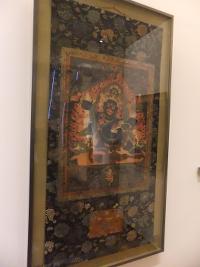***
France/Spain 2011
Day 5 - 21st March - Paris: Musée Guimet - China (Part 8)




Painted Cupola, Afghanistan. 6th-7th c.



Buddhist votive stele. North China. Middle of 6th c.



Bodhisattva Head. Xinjiang. 6th c.-Start of 7th c.



Sculpted wood. Xinjiang. End of 6th c-Start of 7th c.



Scenes of Buddha preaching. Xinjiang. Second half of 6th c.-First half of 7th c.



Scenes of Buddha preaching. Xinjiang. Start of 6th c.




The thing on the right is Fragment of parinirvana scene (Buddha in Nirvana) or Cremation scene. Xinjiang. 7th c.
The caption on the left is not legible: fragments of something about the Buddha
At this point, my camera battery ran out - again. I'd already changed my battery in Père Lachaise, so now I was out of batteries. Luckily I brought my camera battery charger out, so I first took a half-hour break (resting my feet in the process) and then left one battery charging while I wandered off elsewhere.



Seated Arhat: Tamrabhadra, 6th Disciple of the Buddha (?). N China. Liao (947-1125) or Jin (1115-1234) dynasties.


Guanyin seated on Mt. Potalaka. China. 10th-12th c (this was the first [only?] two century dating band I noticed).
The audioguide commented that while the Song faced many enemies from abroad, they had a rich artistic output.



Seated monk. 10th-12th c.



Guanyin with 1000 arms and 1000 eyes, Sahasrabhuja sahasranetra. 5 Dynasties (907-960).
I don't think there're 1000 arms here, but there're certainly a lot more than with another 1000-armed Avalokiteśvara I saw, where each visible arm represented 40 arms. Here's the story of the 1000-armed Avalokiteśvara:
"One prominent Buddhist story tells of Avalokiteśvara vowing never to rest until he had freed all sentient beings from samsara. Despite strenuous effort, he realizes that still many unhappy beings were yet to be saved. After struggling to comprehend the needs of so many, his head splits into eleven pieces. Amitabha Buddha, seeing his plight, gives him eleven heads with which to hear the cries of the suffering. Upon hearing these cries and comprehending them, Avalokiteśvara attempts to reach out to all those who needed aid, but found that his two arms shattered into pieces. Once more, Amitabha Buddha comes to his aid and invests him with a thousand arms with which to aid the suffering multitudes"



Guanyin seated on Mt Potalaka. N China. Song (960-1279) or Jin (1115-1234).
This seems to be before his/her sex change.


Guanyin. N. China. 10th-11th c.



Seated Bodhisattva, tracing a pleading gesture (there seems to be a mistranslation of the Chinese - it should be a sign of instruction). N China. 10th-start of 11th c.



Emperor Wu of the Liang joining a Buddhist community. N China (Shanxi?). 15th-16th c.



God-King or Supernatural Being. N China (Shanxi?). 15th-16th c.
There was also a nice collection of Tibetan art, something not easily found elsewhere.




This was the last in the row so presumably this was Kun-dga' snying-po (1575-1634) surrounded by the mahasiddha
from the series: The religious and the mahasiddha
The master in the centre comes from the tradition of the Jo-nang monastery in Central Tibet.



28 Constellations. Beijing. 1454.




Visions during the bar-do. E. Tibet. 19th c.




Pe-har, Guardian Deity. E. Tibet or China (I LOVE the use of "or" here). 18th c.




Mahakala. Bhutan. 19th c.
Interestingly, this racist deity Mahakala is shared between Buddhism and Hinduism.



Mahakala Bernakchen and friends




The God-protector Mahakala, in the aspect ofNag-po chen-po. Tibet. First half of 18th c.

This was unlabelled



Hayagriva and its spouse. Tibet. End 15th/Start 16th c.
I don't know what it is about Tibetan Buddhism that has religious personnages hanging from the necks of others.




Life of Buddha Sakyamuni. Sino-Tibetan art. First half 17th c.



Amoghasiddhi, jina of the North. 2nd half of 13th c